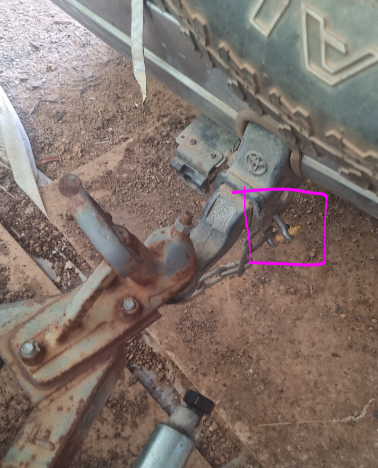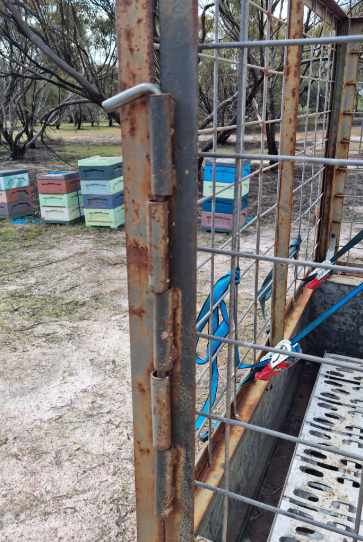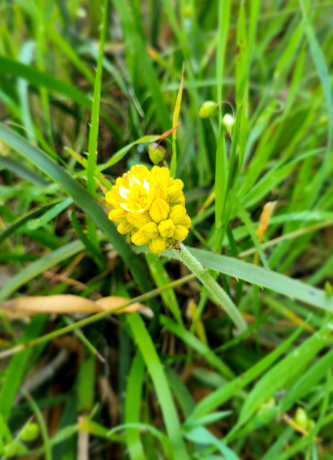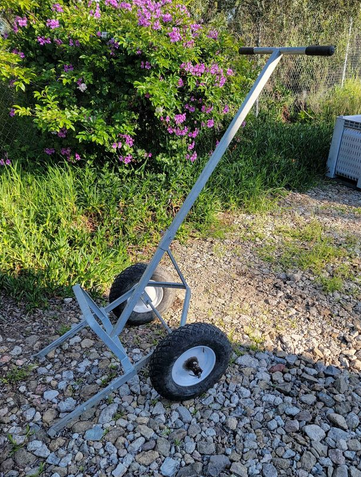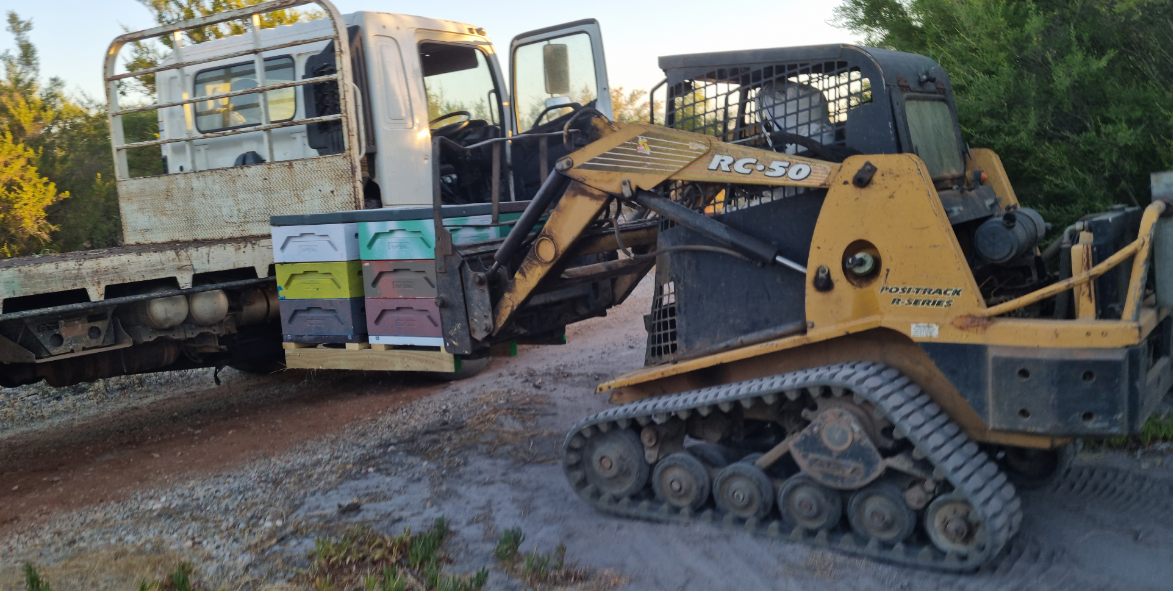Hive lifting, moving and relocation solutions:
This Blog post will probably be a "living document" as we discover the different types lifters and products we will update this page. Over time this will be a compendium of methods to pick from.
Shifting bees at night and red flood lights:
One thing to note first is that bees are being shifted in the dark as all bees are home by then.
the other thing to note is, bees do not easily see red light hence it makes it perfect to illuminate the working area with read light as shown above:
So, lets get back to the topic...
Manual:
- Not recommended due to manual handling and issues with weight and slips and trips.
Either 1 or 2 persons carrying the hive by the box, or by the straps. Usually the lids slip, or bottom boards move and the bees crawl out and you are in direct contact with the bees streaming out, and stinging the living XXXXXX out of you. This is how we started, and its not a good way, 2 guys and a ute, but most people will probably start right there.
Trolleys:
Using a trolley like this in combination with a flatbed trailer using ramps is probably a better idea than lifting them manually of the trailer. Ensure the trolley has large wheels that do not dig themselves into soft underground. Also ensure that your ramps are not too steep or to slippery when dragging the hives up or down ramps. Keep the hives strapped while relocating, or you will "bee" in pain!
Home made hive dolly found on Facebook Marketplace:Kaptar Lift:
Manual or Electrically powered:
We had purchased the manual kaptar lift, as there had been chit-chat about charges only lasting for a certain amount of shifting and also stories about the electrical malfunctioning during rainy nights, in our case we don't have much time to mess around with equipment hence the decision to be manual as it has a set speed, and low / consistent failure rate if at all and can be planned / calculated with.
In recent shifts we noticed that the combination of a regular trolley as above is working quite efficient in a 2 trailer setup. As 1 person is bringing the hives with the trolley above and the second person using the kaptar lift, "forks them" on to the flat bed if not using the ramps depending loading angles etc. It seemed to work quite efficiently that way.

For jobs up to 20-50 hives this tool is working fine, and handy on the smaller ones too as shown below:Same version as the manual, with exception that you have powered wheels and the lifting is done by press of a button.
We had temporarily experimented with red light strips on the Kaptar lift to aid with the shifting at night. I think we picked them up at JayCar, however that experiment only lasted 1x shift until the cables ripped out the LED strip. Also having said that the light emitted from that particualar strip was not very bright. We used a power bank with the USB strip, which we are sure could be built to perfection, as we noticed its rather dark, right at the spot where one wants to drop off the hive, and one usually is standing in the light of the vehicle based red light flood lights from the car. The lifter red light has still got room for improvement!
Peter Debicki's tail gate lifting solution / Kaptar lift action:Found on a Facebook beekeeping group:
This tailgate lifter is made by Healy group, and allows for a simple 1 person operation of ute sized loads. I imagine this could also be mounted to trailers potentially.
B2 Hive lifter from BeeBreedingCentre.com:
I stumbled accross this lifter the other day by accident and found it quite interesting.
Some people are using the Kaptar lifts similar to the B2 shown here, as in lifting of the supers and using the lifters to help under or over super with heavy boxes, taking the weight of your back.
What I do like is the "paddles" shown on this lifter, locking the boxes in place when picking up, but allowing them to slip down into position. I kind of like the engineering in this solution.
We've been told that the "paddles" are built from butt hinges, so feel free to be mechanically creative and build them yourself, as we have not found a commercial entity selling them as such.
HiveHelper:
Discovered on a Facebook Group:
http://www.hivehelper.com.au/
Just recently by coincidence I noticed Brick Trolley's which may be beneficial when moving heavy honey supers assuming you have a little crew going, this trolley might come in handy!
Trailers:
Trailers and beekeeping just seem to have a tendency to grow, until the maximum is reached. It was no different in our story, first started with a 6x4, 8x4, 6m flat top trailer, MR truck with posi truck.
Kennards:
all those lifters go very handy with rented trailers such as the 6m flat top trailer from Kennards as shown below.
You may decide to wheel your hives on to the tray using some form of ramp or simply just fork lift them on to the tray and move them manually into position once on the tray.
However, using this trailer please ensure you start loading from the front of the trailer to ensure the weight at the front, pressing the axle and weight on your rear tyres of your car, or you will face a "swinging trailer" due to unsafe weight distribution on the trailer.
MoveYourself Trailers 24h:
Recently we have discovered Move Yourself trailer hires, especially the 10x6 trailers with loads up to 1499kg. The cool thing is that the return is 24h, as there are distributed 24h fuel stations which offer pickup and return anytime of the day/night. Meaning you would probably be able to get away with an 8 hour lease rather than a 24h one, as you can still return the trailer 02:00 in the morning once you are done with the shifting for instance, rather climbing out of bed early next day to return the trailer. Also the trailer comes with a ramp which drops down 1.2m at the back. It may be a bit steep to go up and down with a trolley or Kaptar lift, especially in the night and with due setting in and making everything slippery. Hence we would suggest taking an extra ramp to lower the ramp angle to make things easier and less dangerous. A foldable wheel-chair ramp may just do the trick. Ramp Champ – Australia's Largest Range of Ramps | RampChamp.com.au might be a good stop to have a look.
When comparing the long flat top trailer from Kennards with the MoveYourself trailer, the GVM ratio is way better on the MoveYourself one. Also when dragging back full honey supers you may be able to return more honey using the 10x6 trailer.
Honey load calculations:
For example the Paradise System 10 Frame WSP supers containing drone comb at 7.2mm cell size, are around 26-29 kg, frames and boxes together.
1499 / 29kg = ~ 51 Supers which could be returned using this super.
The Paradise honey boxes usually fully built frames weigh somewhere around 5-6kg themselves, so out of this you would probably end up with 22kg of honey per box
So 50x boxes in total would yield in 1100kg of honey using the 10x6 trailer and a lot of lifting!
Peter's trailer:
being able to drop down the rails on a trailer is a nice addition and makes load safety fairly simple and fast. You can also see the tailgate lifter on this picture rarely consuming any extra space.
Manual vehicle / trailer based lifters:
Healygroup.com.au seem to have all sorts of handy heavy duty lifting equipment which may be of interest. The one shown on this picture however limit you to lift up or drop down very close to the proximity of your vehicle or trailer. Unless you combine this method with a trolly to then move the hives further away from your vehicle, which could combine both worlds and make it fairly efficient with a two-person team.
Maxilift or Kevrek
Buy a maxilift or Kevrek second hand, and combine the operation with dropping them on the floor and running them into position with the trolleys. Doing this in a two man band can be a very fast operation one person dropping them on the floor, the other rolling them into position.
EasyLoaders and trailers:
This picture is courtesy of Troy Watson kindly sharing his setup constructed by EzyLoader.
The loader is powered by the vehicle 3x 12V batteries.
GVM is 3.5 tonne Troy gets 36 doubles on it and can load another 36 triples on top.
Trailer is 5.5 metres long by 2.1 wide.
Its quite a cool setup for the semi-commercial beekeeper getting a bit sick of Kaptar lifts and or other manual means.
EazyLoader300
Make sure you visit https://www.youtube.com/@aCanadianBeekeepersBlog as I follow Ian along on his journey and he is happy and heavy adopter of the EazyLoaders which seem to work well in his operation. Assisting his team with transporting/deploying hives as well as tasks such as under suppering without ever carrying the weight manually.
However, they come with a bit of a price tag.
Dingo'sThere are all sorts of rental places where you can pick up a Dingo for fairly cheap pricing for the day.
I can recommend https://thehireguyswangara.com.au/products/dingo-hire/ when you are located in Perth WA.
Once you get a introductionary mechanized tool, you will encounter that you will need either a plant trailer, or will operate some more serious truck / MR or even bigger sized vehicle. Now you need heavy duty ramps, and the required GVM on trucks and trailers to make the trip efficient while ensuring you are not overloading your truck in weight or having uneven weight distribution, as well has having the right heavy-duty straps.
Also sites which may have been working for you using smaller tools may no longer be suitable for the slightly bigger equipment you bring along, in terms of mobility and or noise / an nuisance issues to neighbors.
BobCat / Possi Tracks:
And at some stage you end up with MR sized trucks with heavy duty plant trailers and some form of loader, in this case its a posi-track and having customer 4 way pallets setup.
However, once again, your choice of site now has shifted potentially again, as not all sites will allow such heavy equipment in and out, while at others the tracked vehicle is nearly mandatory to avoid bogging and or climbing steep angles with the hives.
And to be truthfully honest, the posi is just a cool tool to toy around with!
Where ever you are in your beekeeping journey, let us know how you shift your hives so we can add it to the above list!
Happy beekeeping,
The QuickWings Team
----------------------------------------------------------
Our content is for informational purposes only and do not form a professional relationship.
Please refer to the full disclaimer on Quickwings pty ltd’s website found here:
https://quickwings.com.au/policies-and-tcs/
----------------------------------------------------------

